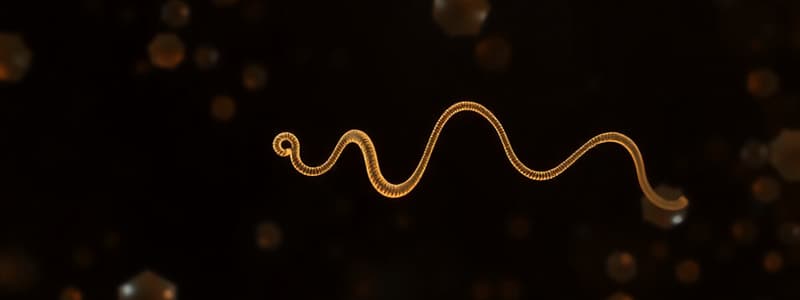Podcast
Questions and Answers
What is the primary function of the GLUT-3 transporter?
What is the primary function of the GLUT-3 transporter?
- Transport glucose in adipose tissue
- Facilitate glucose transport in kidney tubules
- Act as the primary glucose transporter in neurons (correct)
- Transport glucose in liver cells
Which process occurs in the presence of adequate oxygen in cells with mitochondria?
Which process occurs in the presence of adequate oxygen in cells with mitochondria?
- Anaerobic glycolysis
- Cytoplasmic fermentation
- Aerobic glycolysis (correct)
- Oxidative phosphorylation
What type of transport is mediated by SGLT transporters?
What type of transport is mediated by SGLT transporters?
- Energy-dependent transport against a gradient (correct)
- Na+-independent facilitated diffusion
- Passive transport requiring no energy
- Simple diffusion through the cell membrane
Where in the body does glycolysis primarily occur?
Where in the body does glycolysis primarily occur?
Which of the following statements about anaerobic glycolysis is true?
Which of the following statements about anaerobic glycolysis is true?
What is the primary product of anaerobic glycolysis from one molecule of glucose?
What is the primary product of anaerobic glycolysis from one molecule of glucose?
Which hormone primarily inhibits key enzymes of glycolysis during hypoglycemic conditions?
Which hormone primarily inhibits key enzymes of glycolysis during hypoglycemic conditions?
In which cells is glucokinase predominantly found, functioning as a glucose sensor?
In which cells is glucokinase predominantly found, functioning as a glucose sensor?
How many ATP molecules are produced per NADH molecule entering the electron transport chain?
How many ATP molecules are produced per NADH molecule entering the electron transport chain?
Which enzyme has a low Km value, indicating a high affinity for glucose in most tissues?
Which enzyme has a low Km value, indicating a high affinity for glucose in most tissues?
Flashcards
Glucose transport
Glucose transport
Glucose enters cells by facilitated diffusion (no energy needed) or active transport (energy needed).
GLUT transporters
GLUT transporters
A family of proteins that facilitate glucose transport across cell membranes.
GLUT-4
GLUT-4
Glucose transporter abundant in adipose tissue and skeletal muscle; its activity is stimulated by insulin.
SGLT
SGLT
Signup and view all the flashcards
Glycolysis
Glycolysis
Signup and view all the flashcards
Aerobic glycolysis
Aerobic glycolysis
Signup and view all the flashcards
Anaerobic glycolysis
Anaerobic glycolysis
Signup and view all the flashcards
Pyruvate
Pyruvate
Signup and view all the flashcards
Na+-independent facilitated diffusion transport
Na+-independent facilitated diffusion transport
Signup and view all the flashcards
Na+-monosaccharide cotransporter system
Na+-monosaccharide cotransporter system
Signup and view all the flashcards
Anaerobic Glycolysis
Anaerobic Glycolysis
Signup and view all the flashcards
Aerobic Glycolysis
Aerobic Glycolysis
Signup and view all the flashcards
Glucagon's role in glycolysis
Glucagon's role in glycolysis
Signup and view all the flashcards
Insulin's role in glycolysis
Insulin's role in glycolysis
Signup and view all the flashcards
Hexokinase
Hexokinase
Signup and view all the flashcards
Glucokinase
Glucokinase
Signup and view all the flashcards
Energy Yield from Glycolysis (Anaerobic)
Energy Yield from Glycolysis (Anaerobic)
Signup and view all the flashcards
Energy Yield from Glycolysis (Aerobic)
Energy Yield from Glycolysis (Aerobic)
Signup and view all the flashcards
Study Notes
Lecture 19: Glycolysis
- Specific Objectives: Students will understand the glycolytic pathway of glucose and its hormonal regulation.
Transport of Glucose into Cells
- Glucose cannot directly diffuse into cells.
- Two transport mechanisms exist:
- Na+-independent facilitated diffusion transport
- Na+-monosaccharide co-transporter system (SGLT)
Na+-independent facilitated diffusion transport
- Mediated by a family of 14 glucose transporters in cell membranes.
- Examples:
- GLUT-1: Abundant in erythrocytes and blood-brain barrier, but low in adult muscle.
- GLUT-2: The transporter in liver cells.
- GLUT-3: The primary glucose transporter in neurons.
- GLUT-4: Abundant in adipose tissue and skeletal muscle. Insulin stimulates GLUT-4.
Na+-monosaccharide co-transporter system (SGLT)
- An energy-requiring process.
- Transports glucose against a concentration gradient.
- Occurs in epithelial cells of the intestine, renal tubules, and choroid plexus.
Glycolysis
- The glycolytic pathway occurs in the cytoplasm of cells in all body tissues.
- It breaks down glucose to produce energy (ATP) and intermediates for other metabolic pathways.
- Two types of glycolysis:
- Aerobic glycolysis: Breaks down glucose with enough oxygen and mitochondria. Pyruvate is the end product.
- Anaerobic glycolysis: Glucose is converted to lactate without oxygen. This allows ATP production in tissues lacking mitochondria or those deprived of oxygen (e.g., RBCs).
Energy Yield from Glycolysis
- Anaerobic glycolysis: Two ATP are generated for each molecule of glucose converted to two molecules of lactate. There is no net production or consumption of NADH.
- Aerobic glycolysis: The direct consumption and formation of ATP is the same as in anaerobic glycolysis. Two molecules of NADH are also produced per molecule of glucose. NADH produces approximately three ATP in the electron transport chain per molecule. The net energy released is 8 ATP.
Hormonal Regulation of Glycolysis
- Glucagon: Secreted in hypoglycemia or carbohydrate deficiency. Inhibits key glycolytic enzymes (glucokinase, phosphofructokinase-1, pyruvate kinase).
- Insulin: Secreted in hyperglycemia and after carbohydrate feeding. Stimulates glycolytic key enzymes.
Key Enzymes of Glycolysis
- Hexokinase:
- In most tissues, catalyzes glucose phosphorylation.
- Low Km, high affinity for glucose. Efficient phosphorylation even at low glucose concentrations.
- Low Vmax, cannot phosphorylate more sugars than the cell can use.
- Glucokinase:
- Predominant enzyme in liver parenchymal cells and β cells of the pancreas (also called hexokinase D or type IV).
- Functions as a glucose sensor in β cells, determining the threshold for insulin secretion.
- Facilitates glucose phosphorylation in the liver during hyperglycemia.
- High Km, requires higher glucose concentration.
- High Vmax, effectively removes glucose delivered by the portal blood.
- PFK-1 (Phosphofructokinase-1):
- The most important control point in glycolysis.
- Inhibited allosterically by elevated levels of ATP and citrate.
- Activated by high AMP concentrations (indicating low energy stores).
Pyruvate Kinase (PK)
- Catalyzes the conversion of phosphoenolpyruvate (PEP) to pyruvate, forming ATP.
- Deficiency leads to hemolytic anemia due to the lack of ATP in red blood cells, which are essential for maintaining their shape and function. ATP is required to fuel pumps for maintaining the biconcave shape.
Glycolysis Deficiencies
- Anemia results from the reduced rate of glycolysis and decreased ATP production.
- Red blood cell membrane alterations, leading to phagocytosis by macrophages in the spleen.
- Premature death and lysis of red blood cells cause hemolytic anemia.
Reference Books
- Champe, P. C., Harvey, R. A., & Ferrier, D. R. (2005). Biochemistry (5th or 6th Edition). Lippincott's Illustrated Reviews.
- Vasudevan, D. M., Sreekumari, S., & Kannan, V. (2011). Textbook of Biochemistry for Medical Students (6th Edition).
Studying That Suits You
Use AI to generate personalized quizzes and flashcards to suit your learning preferences.


